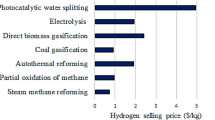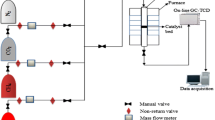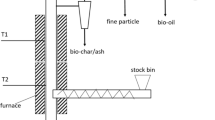Abstract
Hydrogen (H2) is an environmentally-safe power source and its demands is continuously growing worldwide. The most important approach for its generation is water–gas shift (WGS) reaction through various catalysts. This work investigates feasibility of neural network method named Multilayer Perceptron Neural Network (MLP-NN) to estimate CO conversion in WGS reactions based on different active phase compositions and various supports. The approach considers the intrinsic parameters of the catalyst to estimate reaction performance. This research investigates the most influential variables by conducting a sensitivity analysis study on the predictions of the implemented method. The results of the modeling study revealed that the MLP-NN method can accurately approximate the experimental CO conversion values. The sensitivity analysis study revealed temperature and H2 feed concentration are the most crucial parameters on the reaction performance. The reliability of neural network methods is proved such as the MLP-NN to accurately estimate the CO conversion values in WGS reaction.
Graphical Abstract









Similar content being viewed by others

References
Chestnut LG, Mills DM (2005) A fresh look at the benefits and costs of the US acid rain program. J Environ Manage 77(3):252–266
Kemper N (2008) Veterinary antibiotics in the aquatic and terrestrial environment. Ecol Ind 8(1):1–13
Chumachenko Y, Buluchevskiy E, Fedorova E, Nepomnyashchii A, Gulyaeva T, Trenikhin M, Izmailov R, Mironenko R (2019) Hydrodeoxygenation of sorbitol to gasoline-range hydrocarbons over Pt, Pd, Rh, Ru, Ni catalysts supported on tungstated alumina. Biomass Convers Biorefinery 11:1–11
Hájek M, Skopal F, Vávra A, Kocík J (2017) Transesterification of rapeseed oil by butanol and separation of butyl ester. J Clean Prod 155:28–33
Dong Q, Yang F, Liang F, Zhang Y, **a D, Zhao W, Wu L, Liu X, Jiang Z, Sun C (2021) Silver particle on BiVO4 nanosheet plasmonic photocatalyst with enhanced photocatalytic oxidation activity of sulfadiazine. J Mol Liquids 331:115751
Kim K-H, Ihm S-K (2011) Heterogeneous catalytic wet air oxidation of refractory organic pollutants in industrial wastewaters: a review. J Hazard Mater 186(1):16–34
Rj BS, Loganathan M, Shantha MS (2010) A review of the water gas shift reaction kinetics. Int J Chem Reactor Eng. https://doi.org/10.2202/1542-6580.2238
Song C (2010) Introduction to hydrogen and syngas production and purification technologies. Hydrogen and syngas production and purification technologies. Wiley, Hoboken, pp 1–13
Polychronopoulou K, Kalamaras C, Efstathiou A (2011) Ceria-based materials for hydrogen production via hydrocarbon steam reforming and water-gas shift reactions. Recent Patents Mater Sci 4(2):122–145
Hush DR, Horne BG (1993) Progress in supervised neural networks. IEEE Signal Process Mag 10(1):8–39
Haykin S, Lippmann RJ (1994) Neural networks, a comprehensive foundation. Int J Neural Syst 5(4):363–364
Ghasemzadeh K, Aghaeinejad-Meybodi A, Basile A (2018) Hydrogen production as a green fuel in silica membrane reactor: experimental analysis and artificial neural network modeling. Fuel 222:114–124
Cavalcanti FM, Schmal M, Giudici R, Alves RMB (2019) A catalyst selection method for hydrogen production through water–gas shift reaction using artificial neural networks. J Environ Manage 237:585–594
Barati-Harooni A, Najafi-Marghmaleki A (2016) An accurate RBF-NN model for estimation of viscosity of nanofluids. J Mol Liq 224:580–588
Zamaniyan A, Joda F, Behroozsarand A, Ebrahimi H (2013) Application of artificial neural networks (ANN) for modeling of industrial hydrogen plant. Int J Hydrog Energy 38(15):6289–6297
Serra JM, Corma A, Chica A, Argente E, Botti V (2003) Can artificial neural networks help the experimentation in catalysis? Catal Today 81(3):393–403
Wei J, Chu X, Sun XY, Xu K, Deng HX, Chen J, Wei Z, Lei M (2019) Machine learning in materials science. InfoMat 1(3):338–358
Ross JR (2011) Heterogeneous catalysis: fundamentals and applications. Elsevier, Amsterdam
Corma A, Serra J, Serna P, Moliner M (2005) Integrating high-throughput characterization into combinatorial heterogeneous catalysis: unsupervised construction of quantitative structure/property relationship models. J Catal 232(2):335–341
Holeňa M, Baerns M (2003) Feedforward neural networks in catalysis: a tool for the approximation of the dependency of yield on catalyst composition, and for knowledge extraction. Catal Today 81(3):485–494
Omata K, Kobayashi Y, Yamada M (2007) Artificial neural network aided virtual screening of additives to a Co/SrCO3 catalyst for preferential oxidation of CO in excess hydrogen. Catal Commun 8(1):1–5
Basile A, Curcio S, Bagnato G, Liguori S, Jokar S, Iulianelli A (2015) Water gas shift reaction in membrane reactors: theoretical investigation by artificial neural networks model and experimental validation. Int J Hydrog Energy 40(17):5897–5906
Takassi M, Gharibi Kharaji A, Esfandyari M, KoolivandSalooki M (2013) Neuro-fuzzy prediction of Fe–V2O5-promoted γ-alumina catalyst behavior in the reverse water–gas–shift reaction. Energ Technol 1(2–3):144–150
Akubo K, Nahil MA, Williams PT (2019) Pyrolysis-catalytic steam reforming of agricultural biomass wastes and biomass components for production of hydrogen/syngas. J Energy Inst 92(6):1987–1996
Smith A, Keane A, Dumesic JA, Huber GW, Zavala VM (2020) A machine learning framework for the analysis and prediction of catalytic activity from experimental data. Appl Catal B 263:118257
Buitrago R, Ruiz-Martínez J, Silvestre-Albero J, Sepúlveda-Escribano A, Rodríguez-Reinoso F (2012) Water gas shift reaction on carbon-supported Pt catalysts promoted by CeO2. Catal Today 180(1):19–24
de Farias AMD, Barandas AP, Perez RF, Fraga MA (2007) Water–gas shift reaction over magnesia-modified Pt/CeO2 catalysts. J Power Sources 165(2):854–860
Dufour J, Martos C, Ruiz A, Ayuela F (2013) Effect of the precursor on the activity of high temperature water gas shift catalysts. Int J Hydrog Energy 38(18):7647–7653
Fu Q, Deng W, Saltsburg H, Flytzani-Stephanopoulos M (2005) Activity and stability of low-content gold–cerium oxide catalysts for the water–gas shift reaction. Appl Catal B 56(1–2):57–68
Hwang K-R, Ihm S-K, Park S-C, Park J-S (2013) Pt/ZrO2 catalyst for a single-stage water-gas shift reaction: Ti addition effect. Int J Hydrog Energy 38(14):6044–6051
Hwang K-R, Lee C-B, Park J-S (2011) Advanced nickel metal catalyst for water–gas shift reaction. J Power Sources 196(3):1349–1352
Jacobs G, Graham UM, Chenu E, Patterson PM, Dozier A, Davis BH (2005) Low-temperature water–gas shift: impact of Pt promoter loading on the partial reduction of ceria and consequences for catalyst design. J Catal 229(2):499–512
Jacobs G, Ricote S, Davis BH (2006) Low temperature water-gas shift: type and loading of metal impacts decomposition and hydrogen exchange rates of pseudo-stabilized formate over metal/ceria catalysts. Appl Catal A 302(1):14–21
Jeong D-W, Jang W-J, Shim J-O, Han W-B, Roh H-S, Jung UH, Yoon WL (2014) Low-temperature water–gas shift reaction over supported Cu catalysts. Renewable Energy 65:102–107
Jiang L, Li C, Li Z, Zhang S (2013) Effect of additives on the activity of CuO/Ce0.6Zr0.4O2 catalysts for the water–gas shift reaction. Chem Eng Technol 36(11):1891–1898
Kalamaras CM, Petallidou KC, Efstathiou AM (2013) The effect of La3+-do** of CeO2 support on the water-gas shift reaction mechanism and kinetics over Pt/Ce1−xLaxO2−δ. Appl Catal B 136:225–238
Kim CH, Thompson LT (2005) Deactivation of Au/CeOx water gas shift catalysts. J Catal 230(1):66–74
Li Y, Fu Q, Flytzani-Stephanopoulos M (2000) Low-temperature water–gas shift reaction over Cu-and Ni-loaded cerium oxide catalysts. Appl Catal B 27(3):179–191
Liang S, Veser G (2012) Mixed lanthana/ceria nanorod-supported gold catalysts for water–gas-shift. Catal Lett 142(8):936–945
Lin J, Wang A, Qiao B, Liu X, Yang X, Wang X, Liang J, Li J, Liu J, Zhang T (2013) Remarkable performance of Ir1/FeOx single-atom catalyst in water gas shift reaction. J Am Chem Soc 135(41):15314–15317
Mellor J, Coville N, Sofianos A, Copperthwaite R (1997) Raney copper catalysts for the water-gas shift reaction: I. Preparation, activity and stability. Appl Catal A 164(1–2):171–183
Phillips C, Patt J, Moon DJ, Thompson LT (2000) Molybdenum carbide catalysts for water–gas shift
Rhodes C, Hutchings G, Ward A (1995) Water-gas shift reaction: finding the mechanistic boundary. Catal Today 23(1):43–58
Rhodes C, Williams BP, King F, Hutchings GJ (2002) Promotion of Fe3O4/Cr2O3 high temperature water gas shift catalyst. Catal Commun 3(8):381–384
Shinde VM, Madras G (2012) Water gas shift reaction over multi-component ceria catalysts. Appl Catal B 123:367–378
Shinde VM, Madras G (2013) Nanostructured Pd modified Ni/CeO2 catalyst for water gas shift and catalytic hydrogen combustion reaction. Appl Catal B 132:28–38
Shinde VM, Madras G (2013) Synthesis of nanosized Ce0.85M0.1Ru0.05O2−δ (M = Si, Fe) solid solution exhibiting high CO oxidation and water gas shift activity. Appl Catal B 138:51–61
Wang X, Gorte RJ, Wagner J (2002) Deactivation mechanisms for Pd/ceria during the water–gas-shift reaction. J Catal 212(2):225–230
Zhang Y, Chen C, Lin X, Li D, Chen X, Zhan Y, Zheng Q (2014) CuO/ZrO2 catalysts for water–gas shift reaction: nature of catalytically active copper species. Int J Hydrog Energy 39(8):3746–3754
Zugic B, Bell DC, Flytzani-Stephanopoulos M (2014) Activation of carbon-supported platinum catalysts by sodium for the low-temperature water-gas shift reaction. Appl Catal B 144:243–251
Pantoleontos G, Kikkinides ES, Georgiadis MC (2012) A heterogeneous dynamic model for the simulation and optimisation of the steam methane reforming reactor. Int J Hydrogen Energy 37(21):16346–16358
Ali J Neural networks: a new tool for the petroleum industry? In: European petroleum computer conference, 1994. Society of Petroleum Engineers
Essenreiter R, Karrenbach M, Treitel S (1998) Multiple reflection attenuation in seismic data using backpropagation. IEEE Trans Signal Process 46(7):2001–2011
Heidari E, Sobati MA, Movahedirad S (2016) Accurate prediction of nanofluid viscosity using a multilayer perceptron artificial neural network (MLP-ANN). Chemom Intell Lab Syst 155:73–85
Ahmadi MA, Shadizadeh SR (2012) New approach for prediction of asphaltene precipitation due to natural depletion by using evolutionary algorithm concept. Fuel 102:716–723
Sabzevari S, Moosavi M (2014) Density prediction of liquid alkali metals and their mixtures using an artificial neural network method over the whole liquid range. Fluid Phase Equilib 361:135–142
Riedmiller M, Braun H (1993) A direct adaptive method for faster backpropagation learning: the RPROP algorithm. In: IEEE international conference on neural networks. IEEE, pp 586–591
Hagen M, Demuth H, Beale M (1996) Neural network design. PWS Publishing Co, Boston
Benyekhlef A, Mohammedi B, Hassani D, Hanini S (2021) Application of artificial neural network (ANN-MLP) for the prediction of fouling resistance in heat exchanger to MgO-water and CuO-water nanofluids. Water Sci Technol 84(3):538–551
Mohammadi J, Ataei M, Kakaei RK, Mikaeil R, Haghshenas SS (2018) Prediction of the production rate of chain saw machine using the multilayer perceptron (MLP) neural network. Civil Eng J 4(7):1575–1583
Moosavi SR, Wood DA, Ahmadi MA, Choubineh A (2019) ANN-based prediction of laboratory-scale performance of CO2-foam flooding for improving oil recovery. Nat Resour Res 28(4):1619–1637
Azizi S, Ahmadloo E (2016) Prediction of heat transfer coefficient during condensation of R134a in inclined tubes using artificial neural network. Appl Therm Eng 106:203–210. https://doi.org/10.1016/j.applthermaleng.2016.05.189
Tatar A, Barati A, Yarahmadi A, Najafi A, Lee M, Bahadori A (2016) Prediction of carbon dioxide solubility in aqueous mixture of methyldiethanolamine and N-methylpyrrolidone using intelligent models. Int J Greenhouse Gas Control 47:122–136
Chen G, Fu K, Liang Z, Sema T, Li C, Tontiwachwuthikul P, Idem R (2014) The genetic algorithm based back propagation neural network for MMP prediction in CO2-EOR process. Fuel 126:202–212
Chok NS (2010) Pearson's versus Spearman's and Kendall's correlation coefficients for continuous data. University of Pittsburgh
Reddy GK, Smirniotis PG (2019) Water gas shift reaction
Author information
Authors and Affiliations
Corresponding authors
Ethics declarations
Conflict of interest
Authors for this manuscript declare no conflict of interest.
Additional information
Publisher's Note
Springer Nature remains neutral with regard to jurisdictional claims in published maps and institutional affiliations.
Supplementary Information
Below is the link to the electronic supplementary material.
Rights and permissions
About this article
Cite this article
Tangestani, E., Ghanbarzadeh, S. & Garcia, J.F. Prediction of Catalytic Hydrogen Generation by Water–Gas Shift Reaction Using a Neural Network Approach. Catal Lett 153, 863–875 (2023). https://doi.org/10.1007/s10562-022-04019-x
Received:
Accepted:
Published:
Issue Date:
DOI: https://doi.org/10.1007/s10562-022-04019-x



